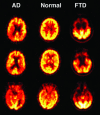Molecular neuroimaging in Alzheimer's disease
- PMID: 15717021
- PMCID: PMC534926
- DOI: 10.1602/neurorx.1.2.206
Molecular neuroimaging in Alzheimer's disease
Abstract
Considerable data exist to support the use of positron emission tomography (PET) and single photon emission computed tomography (SPECT) scanning as biomarkers for Alzheimer's disease (AD). The techniques are reasonably sensitive and specific in differentiating AD from normal aging, and recent studies with pathological confirmation show good sensitivity and specificity in differentiating AD from other dementias. These techniques also can detect abnormalities in groups of asymptomatic and presymptomatic individuals and may be able to predict decline to dementia. However, there are a number of existing questions related to the use of these techniques in samples that are fully representative of the spectrum of patients with dementia. For example, it is unclear how well PET and SPECT perform in comparison to a clinical diagnosis obtained in the same patient group, when autopsy is used as a gold standard. It will also be important to know what PET and SPECT add to the certainty of diagnosis in addition to the standard clinical diagnosis. Despite these unanswered questions, PET and SPECT may have application as biomarkers for AD in a number of clinical and research settings, especially in academic centers, where most of the existing studies have been done.
Figures

Similar articles
-
SPECT and PET imaging in Alzheimer's disease.Ann Nucl Med. 2018 Nov;32(9):583-593. doi: 10.1007/s12149-018-1292-6. Epub 2018 Aug 20. Ann Nucl Med. 2018. PMID: 30128693 Review.
-
Imaging discrepancies between magnetic resonance imaging and brain perfusion single-photon emission computed tomography in the diagnosis of Alzheimer's disease, and verification with amyloid positron emission tomography.Psychogeriatrics. 2014 Jun;14(2):110-7. doi: 10.1111/psyg.12047. Psychogeriatrics. 2014. PMID: 24954834
-
Novel PET/SPECT probes for imaging of tau in Alzheimer's disease.ScientificWorldJournal. 2015;2015:124192. doi: 10.1155/2015/124192. Epub 2015 Mar 23. ScientificWorldJournal. 2015. PMID: 25879047 Free PMC article. Review.
-
Concordance between (99m)Tc-ECD SPECT and 18F-FDG PET interpretations in patients with cognitive disorders diagnosed according to NIA-AA criteria.Int J Geriatr Psychiatry. 2014 Oct;29(10):1079-86. doi: 10.1002/gps.4102. Epub 2014 Mar 29. Int J Geriatr Psychiatry. 2014. PMID: 24687634
-
[Current and future prospects of nuclear medicine in dementia].Rinsho Shinkeigaku. 2017 Sep 30;57(9):479-484. doi: 10.5692/clinicalneurol.cn-001016. Epub 2017 Aug 11. Rinsho Shinkeigaku. 2017. PMID: 28804110 Review. Japanese.
Cited by
-
Use of laboratory and imaging investigations in dementia.J Neurol Neurosurg Psychiatry. 2005 Dec;76 Suppl 5(Suppl 5):v45-52. doi: 10.1136/jnnp.2005.082149. J Neurol Neurosurg Psychiatry. 2005. PMID: 16291921 Free PMC article. Review. No abstract available.
-
Biomarkers for evaluation of clinical efficacy of multipotential neuroprotective drugs for Alzheimer's and Parkinson's diseases.Neurotherapeutics. 2009 Jan;6(1):128-40. doi: 10.1016/j.nurt.2008.10.033. Neurotherapeutics. 2009. PMID: 19110204 Free PMC article. Review.
-
Longitudinal Neuroimaging Analysis in Mild-Moderate Alzheimer's Disease Patients Treated with Plasma Exchange with 5% Human Albumin.J Alzheimers Dis. 2018;61(1):321-332. doi: 10.3233/JAD-170693. J Alzheimers Dis. 2018. PMID: 29154283 Free PMC article.
-
Biomarkers for prediction and targeted prevention of Alzheimer's and Parkinson's diseases: evaluation of drug clinical efficacy.EPMA J. 2010 Jun;1(2):273-92. doi: 10.1007/s13167-010-0036-z. Epub 2010 Jun 29. EPMA J. 2010. PMID: 23199065 Free PMC article.
-
The validity of biomarkers as surrogate endpoints in Alzheimer's disease by means of the Quantitative Surrogate Validation Level of Evidence Scheme (QSVLES).J Nutr Health Aging. 2009 Apr;13(4):376-87. doi: 10.1007/s12603-009-0049-2. J Nutr Health Aging. 2009. PMID: 19300886 Review.
References
-
- Kety SS. Human cerebral blood flow and oxygen consumption as related to aging. Res Publ Assoc Res Nerv Ment Dis 35: 31–45, 1956. - PubMed
-
- Frackowiak RSJ, Pozzili C, Legg NJ, Du Boulay GH, Marshall J, Lenzi L et al. Regional cerebral oxygen supply and utilization in dementia: a clinical and physiological study with oxygen-15 and positron tomography. Brain 104: 753–778, 1981. - PubMed
-
- Friedland RP, Budinger TF, Ganz E, Yano Y, Mathis CA, Koss B et al. Regional cerebral metabolic alterations in dementia of the Alzheimer type: positron emission tomography with [18F]Fluorodeoxyglucose. J Comput Assist Tomogr 7: 590–598, 1983. - PubMed
-
- Benson DF, Kuhl DE, Hawkins RA, Phelps ME, Cummings JL, Tsai SY. The fluorodeoxyglucose 18F scan in Alzheimer’s disease and multi-infarct dementia. Arch Neurol 40: 711–714, 1983. - PubMed
-
- Johnson KA, Mueller ST, Walshe TM, English RJ, Holman BL. Cerebral perfusion imaging in Alzheimer’s disease: use of single photon emission computed tomography and iofetamine hydrochloride I 123. Arch Neurol 44: 165–168, 1987. - PubMed
Publication types
MeSH terms
Grants and funding
LinkOut - more resources
Full Text Sources
Other Literature Sources
Medical

